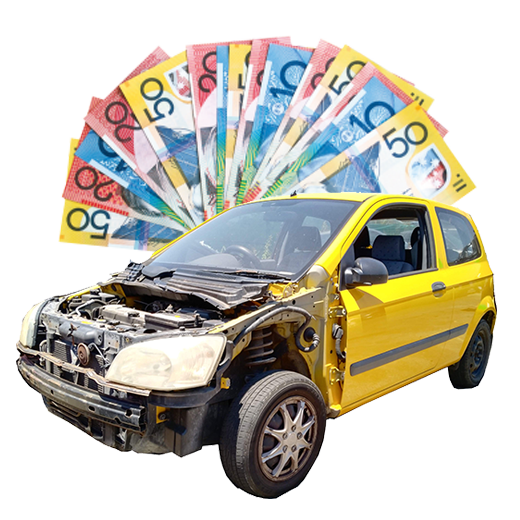When a car is damaged, old, or has some serious mechanical problems, you can often get more money for it by selling it for parts rather than trying to sell it whole. The idea is to take the car apart and sell the individual components—like the engine, gearbox, doors, and even the stereo—to mechanics, car enthusiasts, or people online. It’s a great option when the cost of repairs is more than the car is actually worth.
Deciding If Parting Out Your Car Is Worth The Hassle
Before you grab your toolbox, you need to have an honest think about whether selling your car for parts is the right move. It’s not just about the potential cash; it’s a serious commitment of your time, space, and energy. For some cars, it’s a fantastic way to make money, but for others, it can be a massive waste of time.
Usually, the thing that gets people thinking about this is major damage. If your car’s been in a prang and the insurance company has written it off, or if the engine has blown, the value of its working parts is often way more than the value of the broken-down car. Think about it: the doors, alternator, seats, and wheels are all still perfectly good and can fetch a decent price.
When Is It a Good Idea?
Some cars are just perfect for dismantling. If you've got an older model that has a bit of a cult following, like a classic Holden or Ford, you might be sitting on parts that are hard to find and in high demand. Even popular, everyday models that are known for certain parts failing can be a goldmine. Your working components could be exactly what another owner is desperately looking for.
To help you figure it out, have a look at this decision tree. It walks you through the main questions you need to ask yourself.
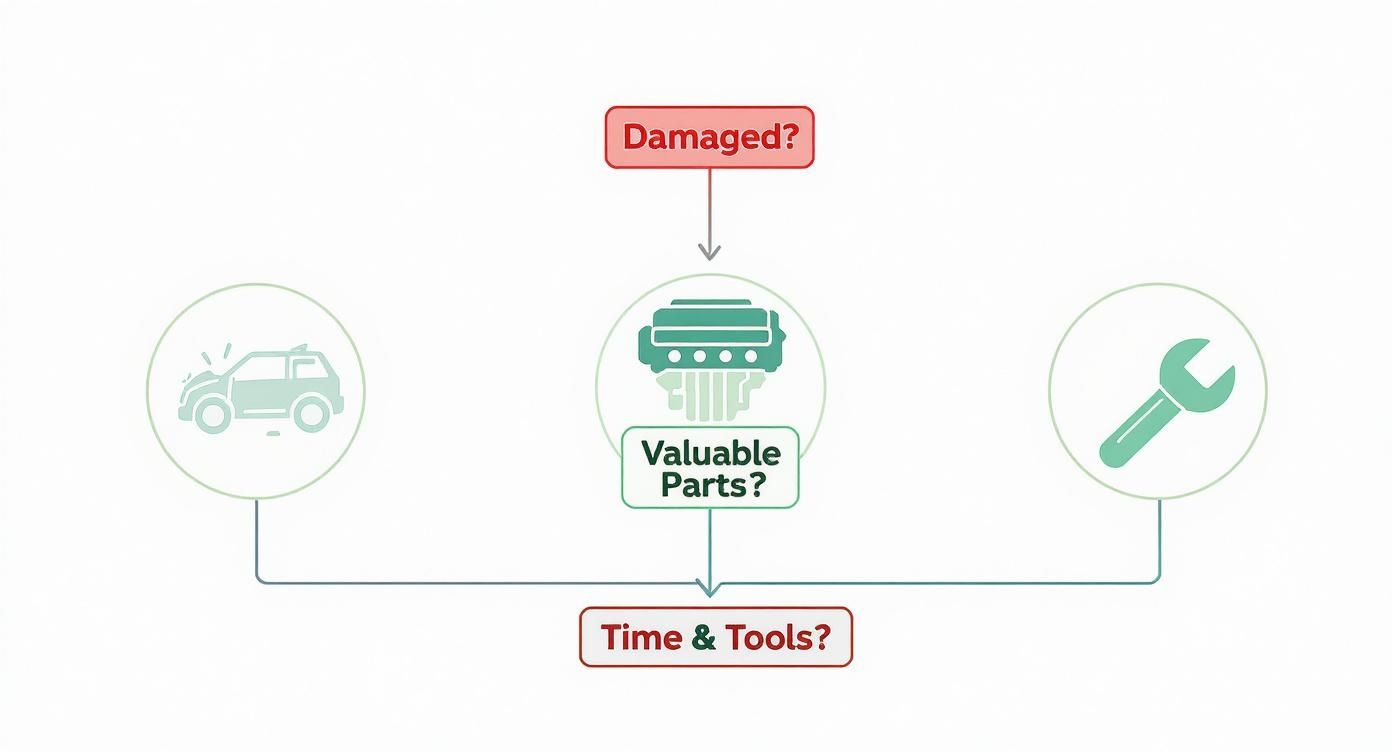
As you can see, the perfect candidate for parting out is a car that isn't roadworthy anymore but is full of valuable, working parts—and you’ve got the setup to handle the job.
Weighing Up the Effort vs. the Reward
Be realistic about what’s involved. Do you actually have the right tools? A garage or shed to work in? The mechanical know-how to pull parts off without breaking them? It’s not a simple weekend project. Selling a car piece by piece means you'll be:
- Dismantling: Carefully taking the car apart.
- Inventory: Making a list of every part, cleaning them, and taking good photos.
- Listing: Writing detailed ads for online marketplaces.
- Negotiating: Haggling with buyers over prices.
- Shipping: Packing and posting heavy, awkward items all over the country.
You really have to balance the potential profit against your own time. If you sink 100 hours into the project just to make an extra $500, you probably would have been better off just selling it to a wrecker for a quick, hassle-free payment.
If you're still weighing things up, our guide on where to sell a vehicle in Australia provides some great insights to help you make the right choice. It’s all about finding that sweet spot between getting the most cash and saving yourself a headache.
How to Nail the Pricing for Your Car's Components
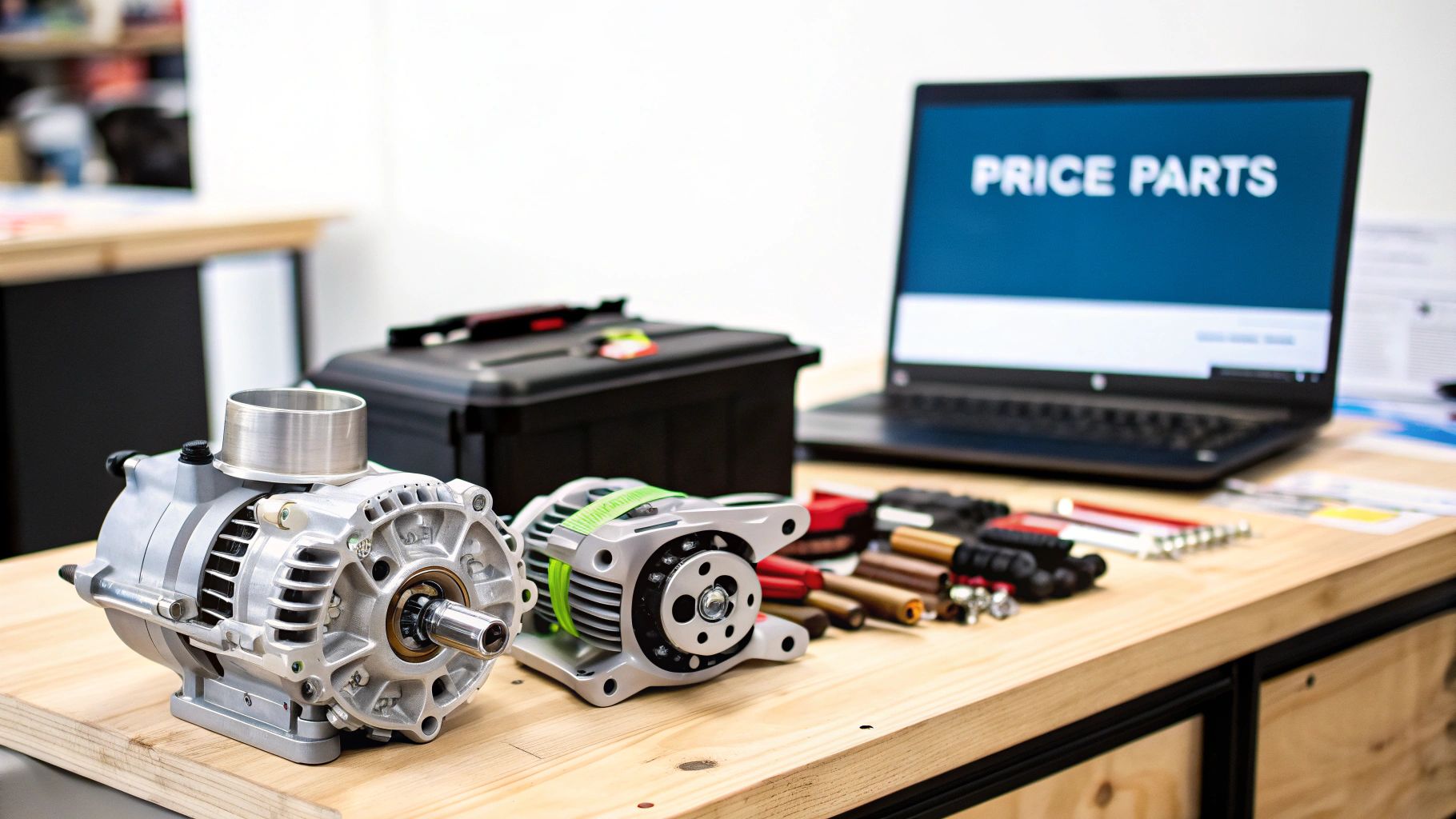
Alright, you've decided to part out your car. Now comes the make-or-break step: figuring out what everything is worth. This is where you can either make a tidy profit or leave a lot of money on the table. Guessing just won’t work. You need to do a bit of homework to avoid underselling your best bits or pricing them so high that nobody bites.
Think of yourself less as a car owner and more as a parts specialist for a moment. Your best friend in this process is real-world data from the places your potential buyers are already browsing.
Start Digging on Online Marketplaces
Your first port of call should be platforms like eBay and Gumtree. Jump on and search for your car's specific make and model. But here's the pro tip: don't just look at what people are asking for. The real treasure is in the sold listings. On eBay, you can easily filter your search to see what prices parts have actually sold for recently. This is the truth serum for pricing – it tells you what people are genuinely willing to pay.
For instance, you might see a seller listing a headlight for $150, but a quick check of the sold history shows they're consistently going for around the $95 mark. That $95 is your real benchmark. Jot down the going rates for the big-ticket items from your car, such as:
- The complete engine assembly
- The gearbox (transmission)
- Headlights and tail lights
- Doors, bonnet, and other body panels
- The alternator and starter motor
This little bit of research gives you a solid price list for your most valuable components and a realistic idea of what you can expect to earn. To get a better feel for what's most in-demand, our guide to auto parts recycling can help you identify the high-value items.
Be Honest About Condition and Kilometres
Let's be realistic – not all parts are created equal. A pristine driver's seat from a car with 50,000 km on the clock is a world away from a faded, worn-out one from a vehicle that's done 250,000 km. You have to be brutally honest with yourself about the condition of each part to set a fair price.
A simple 'Excellent', 'Good', or 'Fair' grading system can be a huge help here. 'Excellent' is for parts that look almost new, 'Good' for those with minor wear, and 'Fair' for anything that's functional but has seen better days. Always be upfront about scratches, small dents, or wear in your listings. Buyers respect honesty and it builds trust.
When it comes to mechanical parts like an engine or alternator, the car's mileage is king. A lower-kilometre component can easily fetch a premium because it suggests less wear and a longer life ahead. Make sure you clearly state the vehicle's mileage in your listings for these items.
Check in With Local Wreckers and Enthusiast Forums
While online marketplaces give you a great national overview, don't forget about your local market. It's worth spending ten minutes calling a couple of local auto wreckers in Adelaide. Ask for a quote on a specific part, like a front bumper for your model. This gives you a baseline for what local buyers, who want to skip shipping hassles, might pay.
And don't overlook the power of enthusiast forums. If you're parting out a classic, a performance model, or something a bit niche, these forums are goldmines. Members are constantly discussing parts sales, giving you a direct line into what collectors and dedicated DIYers will pay for those hard-to-find bits.
Getting this right is important. The Australian motor vehicle repair and maintenance industry, which relies on this flow of used parts, was valued at around AUD 15.8 billion in 2024. With the average age of an Aussie car now creeping over 10 years, there’s a massive, ongoing demand for good quality used parts. This is what keeps the whole business of selling a car for parts ticking.
Creating Listings That Actually Attract Buyers
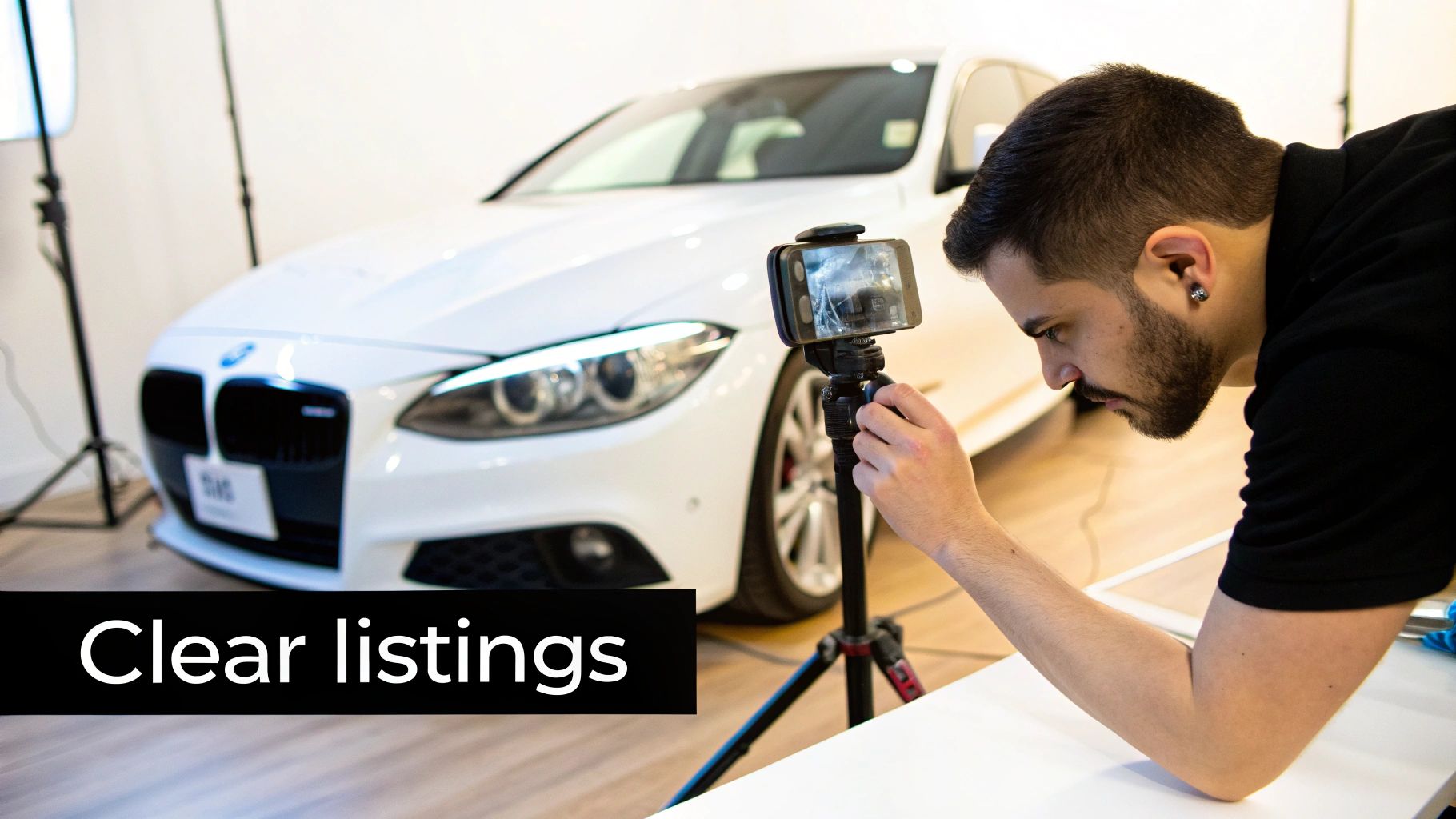
With your prices figured out, it's time to get down to the real work of selling your car for parts. A great price means nothing if buyers can’t find your listings, or worse, don't like what they see when they do. This is where you turn a pile of grimy components into cash.
First things first: clean your parts. Seriously. First impressions are everything, even for a used alternator. A bit of degreaser and a good scrub can make a world of difference, not just to its appeal but to its final sale price. A clean part looks cared for and gives the buyer confidence they aren't just buying another problem.
Mastering Your Photos and Descriptions
You don’t need a professional photography studio. Your phone is fine, but good lighting and a clean, uncluttered background are non-negotiable. Take photos from every conceivable angle, making sure to get clear shots of any identifying marks like part numbers or logos.
Most importantly, be brutally honest. Photograph any damage—scratches, small cracks, or signs of wear. Highlighting the flaws builds trust and heads off any potential disputes down the track.
Think of your listing description as your 24/7 salesperson. "Ford Falcon Headlight" just won't cut it. A description that actually sells includes:
- The precise part name: "Driver's Side Headlight Assembly" instead of just "headlight."
- The donor vehicle's full details: "From a 2009 Ford Falcon FG XR6."
- The part number: This is the holy grail for buyers. It's how they confirm compatibility.
- Honest condition notes: Mention if it's in perfect working order and detail any of the cosmetic flaws you photographed.
- Vehicle mileage at removal: This is crucial for major mechanical parts like engines, transmissions, and alternators.
Put yourself in the buyer’s shoes. What information would you absolutely need before you felt confident enough to click 'buy'? The more detail you provide upfront, the fewer questions you'll have to field and the quicker you'll make the sale.
Choosing Where to Sell Your Parts
Where you list your parts matters just as much as how you list them. Different platforms cater to different audiences, so a multi-pronged approach is often the smartest way to go when you're selling a car for parts.
Platform Comparison for Selling Car Parts
Deciding where to list can feel overwhelming. Each platform has its own quirks, fees, and typical buyer. This table breaks down the most popular options in Australia to help you choose the right home for your parts.
| Platform | Best For | Fees | Pros | Cons |
|---|---|---|---|---|
| eBay | Rare, high-demand, and shippable parts; reaching a national audience. | Insertion fees + Final value fees (often 10-15%). | Massive buyer base, good seller protection, structured listing process. | Fees can significantly eat into profits, high competition. |
| Gumtree | Large, heavy items (engines, gearboxes, doors) for local pickup. | Generally free; optional paid features for visibility. | Free to list, strong local reach, simple interface. | Less seller protection, more chance of low-ball offers and no-shows. |
| Facebook Marketplace | Similar to Gumtree; great for quick local sales and bulky items. | Free for local pickup listings. | Huge user base, integrated with social media, very easy to use. | Can be chaotic, filled with time-wasters, minimal seller protection. |
| Specialist Forums | Niche, classic, or performance car parts (e.g., Ford forums, JDM groups). | Varies; often free for members or requires a small subscription. | Highly targeted, knowledgeable, and passionate buyers. | Smaller audience, listing rules can be strict, slower sales process. |
Ultimately, a mix-and-match strategy often works best. List smaller, easy-to-ship items on eBay while using Gumtree and Facebook Marketplace for the big, bulky stuff you'd rather not post.
This digital-first approach is key. The Australian vehicle parts ecommerce market is a big deal, generating over US$1 billion in 2024. But as data on online automotive trends shows, high cart abandonment rates prove that buyers are picky. A clear, detailed, and trustworthy listing is your best weapon to convert a casual browser into a happy customer.
Navigating Australian Paperwork and Legal Rules
https://www.youtube.com/embed/yfStB5hJeuM
Once you start pulling a car apart, it's no longer considered a roadworthy vehicle in the eyes of the law. This is a critical point. You have a legal responsibility to notify your state's transport authority, and skipping this step can lead to a world of pain, like copping registration renewal notices or even fines for a car that technically doesn't exist anymore.
Your main job here is to officially deregister the vehicle. The exact process has its own quirks depending on where you are – whether you're dealing with VicRoads, Service NSW, or TMR in Queensland – but the core task is the same. You'll need to fill out and lodge an "Application for Cancellation of Registration," which you can usually download straight from their website.
This form is what tells the government your car is officially off the road, so they stop billing you for rego and compulsory third-party insurance.
Handling Plates and Proof of Ownership
When you cancel the registration, you'll have to hand in the number plates. Don't be tempted to hang them on the garage wall as a souvenir. Returning them to your local motor registry is a mandatory part of the process and acts as physical proof the car is no longer in use.
You’ll also need to hang onto your proof of ownership documents. Think of the original Certificate of Registration or the bill of sale you got when you first bought the car. Even though it's now a collection of parts, you still need to prove it's yours. This becomes especially important when a scrap metal dealer comes to tow away the leftover chassis – they'll definitely ask for this paperwork.
Pro Tip: Keep a clear and organised paper trail for everything. When you cancel the rego, make sure you walk away with a receipt or a confirmation letter. This piece of paper is your best defence against any future mix-ups or administrative errors that might try to link you to the now-dismantled car.
Your Responsibility with the VIN
Every car has a Vehicle Identification Number (VIN) stamped onto its chassis, which is basically the car's legal fingerprint. It’s vital that you don't tamper with or remove the VIN plate from the car's main body.
That VIN needs to stay with the chassis right up until the moment it's handed over to a licensed scrap metal recycler. They use this number to officially record the vehicle's destruction, which completes its legal life cycle. Getting these details right ensures your little side project is not just profitable, but also 100% above board.
What to Do with the Leftover Car Shell
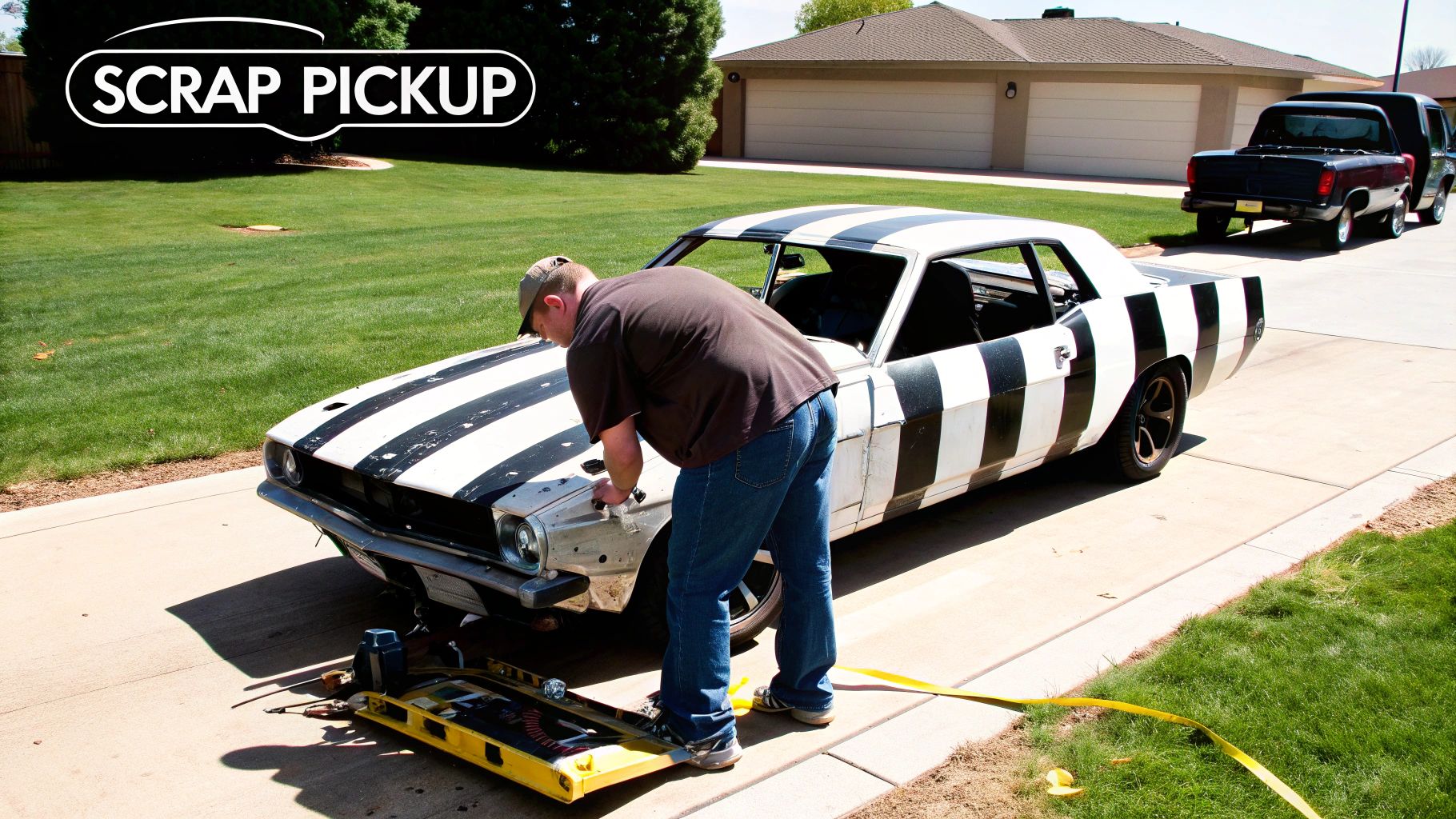
So, you’ve pulled every last sellable part off your car. Now you’re left with the final piece of the puzzle: the bare metal chassis. It might look like junk, but that shell is scrap metal with real value. Handling it properly is the last step to finishing your project cleanly, legally, and with a bit more cash in hand.
Your best bet here is a local scrap metal dealer or a dedicated car removal service. These companies are in the business of collecting and recycling vehicle bodies. They won't pay for the parts you’ve already sold, but they will give you cash for the weight of the metal. Every little bit counts.
Finding a Good Scrap Dealer
Start calling around for quotes. A reputable dealer will be transparent about their process from the get-go. They'll likely ask for your location and the car model, and confirm that it’s just the shell you're getting rid of.
The good ones offer free collection, which is a huge help. It saves you the headache and cost of organising a tow truck.
Before they turn up, get your paperwork in order. They’ll need to see:
- Proof of Ownership: Your original bill of sale or the Certificate of Registration.
- Photo ID: A valid driver's licence to verify who you are.
- Deregistration Confirmation: The receipt you got when you cancelled the rego.
This isn't just bureaucracy. It’s a legal requirement to prove the car isn't stolen property. For a deeper dive into this side of things, our ultimate guide to scrapping a car in Australia has all the details.
Handling Leftover Fluids Safely
There's one last, critical job before the shell can go. It must be completely drained of all fluids. This means any leftover engine oil, coolant, brake fluid, and petrol has to come out. Whatever you do, don't pour these down the drain or onto the ground.
Most local councils in Australia have specific waste management facilities that accept hazardous materials like these, often for free. A quick search on your council's website will point you to the nearest drop-off location, making sure you dispose of everything responsibly.
Wrapping up this process correctly matters. The demand for used parts is a massive driver for Australia's auto parts aftermarket, valued at roughly USD 9.94 billion in 2024. With cars on our roads getting older, this market is only set to grow, making responsible car dismantling more important than ever. Your efforts are part of a much bigger picture.
Common Questions About Parting Out a Car
Diving into the world of selling a car for parts naturally brings up a lot of questions. It's a process with more than a few moving pieces, and you’ll want to have all your ducks in a row before you start unbolting anything. Let's walk through some of the most common queries we hear from people in your exact situation.
Getting these details right from the start can make the difference between a profitable project and a drawn-out headache.
Do I Need a Special Licence to Sell Car Parts?
This is usually the first question on everyone's mind, and thankfully, the answer is pretty straightforward. If you're parting out a single car that you personally own, you generally do not need a special business licence. You're just selling off your own property, piece by piece.
Things get a bit more complicated, however, if this becomes a regular habit. The moment you start buying cars with the specific intent to dismantle them for profit, you're stepping into business territory. At that point, you'd most likely need to register for an Australian Business Number (ABN) and could fall under state regulations for motor wreckers. If you're thinking of doing this more than once, it’s a good idea to have a chat with your local council and your state's fair trading office first.
What Are the Most Profitable Car Parts to Sell?
While just about every part has some value, a few key components are the real money-makers. Focusing on selling these first will give you the biggest and fastest return on your time and effort.
- Engine and Transmission: These are the big-ticket items. An engine with low kilometres or a well-maintained gearbox is always in high demand from both professional mechanics and weekend warriors.
- Catalytic Converter: Don't underestimate this one. The precious metals inside make them surprisingly valuable, and they almost always sell quickly.
- Body Panels and Lights: Straight, undamaged doors, bonnets, bumpers, and lights are gold to anyone fixing up a bingle. These are your bread-and-butter sales.
- Unique or Hard-to-Find Items: Think beyond the obvious. For certain models, a specific set of alloy wheels, a rare interior trim piece, or even an original factory stereo can be worth a lot to an enthusiast trying to complete a perfect restoration.
How Should I Ship Large or Heavy Parts?
Getting the big, heavy stuff to a buyer can be a logistical nightmare. For bulky items like an engine, a gearbox, or even a door, your best bet is always local pickup. Advertising on platforms like Gumtree or Facebook Marketplace makes this simple, as buyers in your area can come to you.
If you absolutely have to ship something large, you'll need to look into a freight service. The trick is in the prep work—you need to securely strap the part to a pallet and wrap it thoroughly. For parts that are heavy but not quite pallet-sized, couriers such as Toll or TNT are often a good option.
A little tip from experience: don't cheap out on packaging. That extra layer of bubble wrap or foam can be the difference between a five-star review and a damaged part claim. For anything valuable, always spring for shipping insurance. It's worth the small cost for the peace of mind.
What If I Can't Sell All the Leftover Parts?
Let's be realistic: you're almost certainly not going to sell every last nut and bolt. You will end up with a pile of less desirable bits and pieces. The key is not to let them take over your garage for the next five years.
The best strategy is to bundle them. Group all the miscellaneous plastic bits, brackets, and hoses into a single "bulk lot" and list it on a local marketplace for a bargain price. You’d be surprised what a home mechanic or restorer will grab if the price is right.
For whatever remains after that, it's time for a trip to a scrap metal recycler. You won't make a fortune, but it's the right way to responsibly clear out the last of the clutter and officially call the project done.
If the whole process of dismantling, listing, and shipping sounds like more hassle than it's worth, Auto Removal Adelaide offers a dead-simple alternative. We pay cash for unwanted, old, or damaged vehicles and handle all the heavy lifting for you. Learn more at our website.

